- Joined
- Jan 30, 2012
- Messages
- 6,645
- Reaction score
- 3,511
- Location
- Thailand
- Current Phone Model
- iPhone 7 Plus JB

Thankfully, that old cliché holds true here: It's what's inside that counts. In this case, "what's inside" is one of Qualcomm's 2.3GHz quad-core Snapdragon 800 chips along with 2GB of RAM -- a combination that runs the show admirably. Alas, things get considerably less charming when you dock the device into the Padfone Station. The frame the phone slides into is an unwieldy, chunky thing that creaks and groans even when you apply light pressure to it. And those bezels? Oh my. There's close to a full inch of black nothingness bounding that 9-inch display on all sides, which only serves to make the tablet look like a cheap digital picture frame from holidays long past. In fairness, the bezels aren't all bad -- they provide plenty of room for meaty thumbs to rest, and they house a pair of (sadly lacking) front-facing speakers.
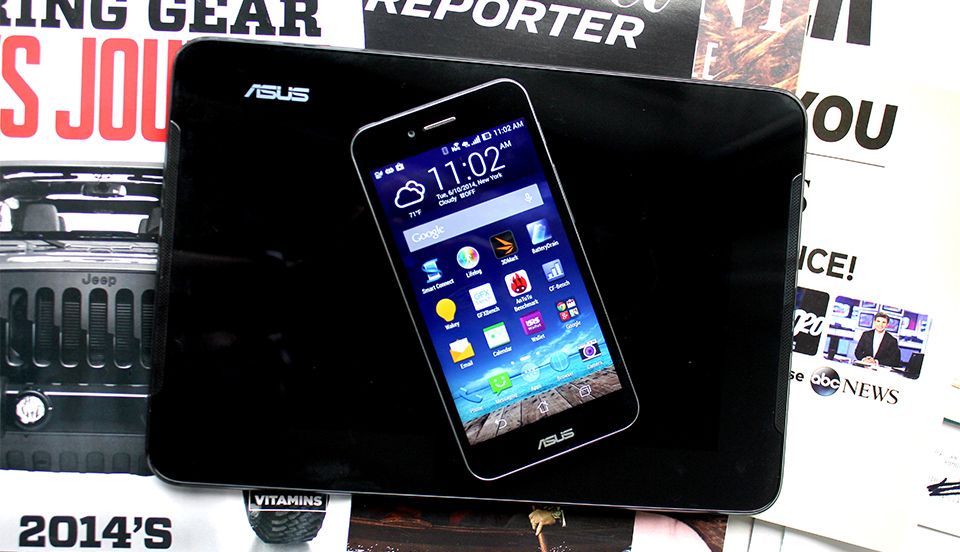
I doubt ASUS knew it was carving out a place in Android history when it revealed the first Padfone back in 2011. That's not just because it starred in an amazing product unveiling, either -- the resulting Padfone line might be the last surviving example of the "phone-as-brain" movement that fell out of vogue a few years back. In all that time, though, there's one thing US fans could never do: walk into a store and actually buy one. That changes now.
After three years and three Padfones, ASUS has finally brought its curious phone/tablet hybrid to the US in the form of the $200 (with contract, anyway) Padfone X. You'd think years of iterating and refining would result in the finest, kookiest model yet, and on paper that certainly seems to be the case. But what is it like to actually use? Has ASUS managed to put its best foot forward for the Padfone's American debut?
PROS
- Good display quality on both the phone and tablet
- Ample horsepower
- On-contract price is just right
- Switching between phone and tablet modes can be awkward
- Uninspired, clunky design
- Speaker quality leaves much to be desired
ASUS' Padfone X promises seamless switching between phone and tablet modes, but the company's execution doesn't live up to expectations. While some might like the curious combo for its low price tag, most people would be better served by two separate devices.
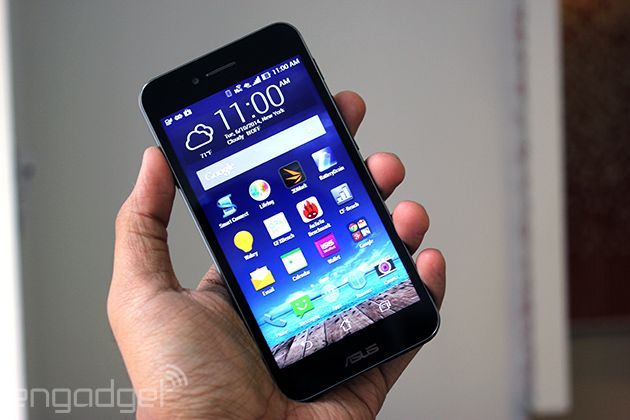
Hardware
The sad truth of the Padfone is that the phone itself -- quite literally the brains of the operation -- is the most attractive thing about it. Why's that sad? Because its design is dull to the point of inducing ennui. That's a shame too, especially considering this newer, faster version of the Padfone doesn't look nearly as handsome as last year's model, the Padfone Infinity. Your taste may differ, but the Infinity featured cleaner lines and a handsome brushed-metal finish that stands in stark contrast to all the bland, dark, chintzy-feeling plastic featured on the X.
So yes, the Padfone X isn't what you'd call a looker. The sole standout here is the 5-inch 1080p display. As you'd expect, the speaker and front-facing, 2-megapixel camera sit just above that satisfying screen, while a shiny ASUS logo greets you from below. Taking a little tour around the rest of the phone yields precious few surprises: You've got the sleep/wake button and volume rocker nestled on the phone's right edge. In fact, the only real hints that the Padfone aspires to something bigger (literally) are two holes on the phone's bottom, on either side of the micro-USB port. They're meant to anchor the phone firmly into the Padfone Station, the beefy exoskeleton that converts 'fone to pad.
That's not to say the Padfone X is completely bland, though. Peer a little closer and you'll see its removable backplate is flecked with tiny silver specks. It's perhaps the most minute concession to style I've ever seen on a phone, if only because the effect is so subtle you'll outright miss it most of the time. The rest of the X's rear isn't nearly as subdued -- a 13-megapixel rear camera lives just left of center, with the LED flash and speaker grille sitting to the east and south of it, respectively. Once those are out of the picture, all that's left to capture your eye are AT&T and Padfone logos emblazoned prominently on the back. Assuming you manage to pry off that rear plate, you'll find the microSD reader (which was notably absent in last year's model) and microSIM card slot parked next to a 2,300mAhbattery.

Oh, and if you're really into the idea of the Padfone as a true all-in-one machine, you can pick up a specially designed Bluetooth keyboard to go with it. It makes the combined device much heavier thanks to a sizable built-in battery (which can't be used to charge the tablet, unfortunately), and the dearth of space ASUS had to work with made for some frustrating design decisions. Consider the layout: It's about as cramped as you'd expect a keyboard this size to be, and certain critical keys like the apostrophe are only accessible by way of the Function key. That's not to say it's all bad, though. The trackpad? An absolute joy to click. You'll also get days of use out of the thing, though whether or not you'll want to is another story entirely. Trust us: Pass on this unless you're absolutely desperate.
DISPLAY AND SOUND
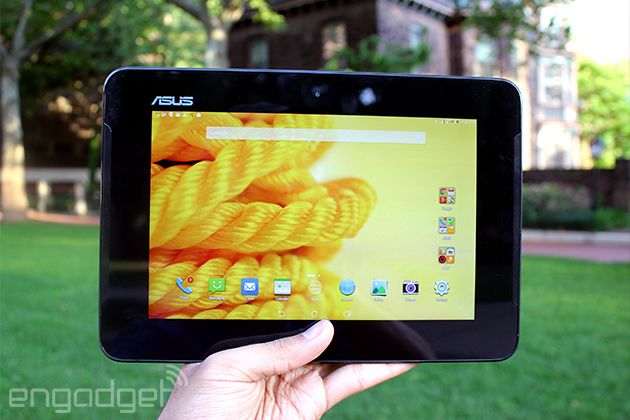
ASUS' designers may have been half-asleep when they crafted the Padfone X, but someone along the line made sure it at least got a solid pair of screens. Ironically enough, it's the smaller display that shines the brightest here -- the 5-inch 1080p panel is the crisper of the two since it packs nearly twice as many pixels per inch as the tablet's screen does (449 ppi versus 214, if you're curious). Colors on both the big and small displays are vibrant and have just the right amount of pop -- no seared retinas here, thanks very much. A preloaded app called "Splendid" lets you muck around with color hue, saturation and balance in case you've got some especially persnickety eyes. Viewing angles are more than respectable, too, with hardly any color distortion even when you peer in from the most awkward angles. My only real niggle is that maximum brightness for both screens is lacking once you take the Padfone outdoors.

Considering the whole point of buying a Padfone X is to have a hot-swappable duo of displays, ASUS gets kudos for not skimping on those Super IPS+ LCD panels. That said, it's earned itself a few demerits for some depressing speaker quality. The phone itself has just the one largely wimpy speaker on its back, and the lackluster sound it puts out is right in line with my low expectations. You'd think that with a pair of front-facing speakers, the Padfone X's tablet form would be able to pump out jams with at least a little more panache. Not so, sadly. My usual suite of test tracks sounded airy and insubstantial through those drivers; the mids and highs of Sutton Foster's jaunty crooning were well-rendered, but there was a distinct lack of support in the low end that left me wanting much more. Trust me: You'll want to run your collection of drum n' bass tracks through a pair of headphones instead.
Or maybe you shouldn't, since the review unit ASUS provided me occasionally did something a little ridiculous. You see, when you're playing music or watching a movie with the Padfone docked in tablet mode, the audio gets routed through the Station's two front-facing speakers. Makes sense, no? One time, though, when I plugged headphones into the proper jack, I heard audio through the headphones... and through the phone's rear speaker. So much for privacy. To be fair, it hasn't happened since, but I've reached out to AT&T anyway for comment. I'll update this review if I learn more. For now, it's possible the issue had something to do with the fact that I was testing a pre-production (read: not-final) unit.
SOFTWARE
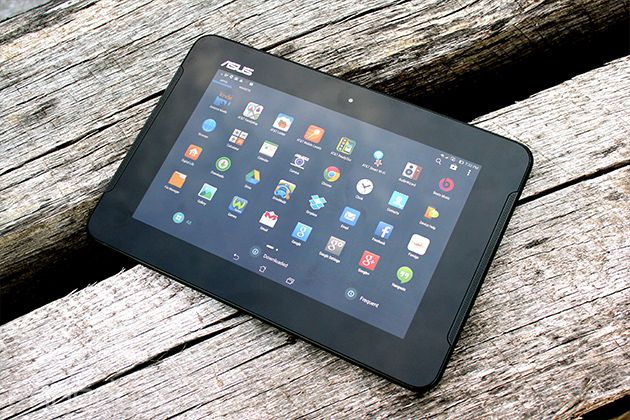
With the Padfone being as downright kooky as it is, it's a bit surprising to see how little ASUS fiddled with Android 4.4.2. There are splashes of paint here and there -- a rejiggered launcher that lets you sort and hide apps, a circle-heavy notification shade that looks like it came from the Galaxy S5, a slightly cramped default keyboard -- but they never completely obscure the rich flavor of KitKat that lurks below the surface.
Seems like AT&T was more than happy to pick up where ASUS left off. You guessed it: The Padfone X is just packed to the gills with AT&T bloatware, from account-management apps to game portals like WildTangent to Beats Music. If you're anything like me, your blood pressure starts to rise at the first sign of carrier intrusion -- thankfully that cruft can be easily uninstalled from the device's settings. In fact, you don't even need to go that far if all you want is to remove the offending apps from your sight.
The Padfone X has two distinct personalities, but its software sometimes seems ill-equipped to handle both of them. A handful of the applications that come preloaded on the Padfone just don't work the way you'd expect once you slot the phone into its tablet dock. You see, everything hinges on ASUS' Dynamic Display mode, which essentially helps you manage the apps that should and shouldn't switch into tablet mode when you dock the phone.
Unless you're running one of a small number of supported apps when you dock, you'll be prompted to make a decision: Should you restart the app in Pad mode? Or add it to the Dynamic Display list, where it will run with a blown-up version of its usual, phone-centric interface? Some apps (like YouTube, for one) don't give you that option at all, so you're forced to restart it each time you dock or undock the Padfone. The whole thing is a lot less odious than it sounds -- it'll take an extra tap or two to jump back into things -- but we can't help but yearn for something more seamless.
CAMERA
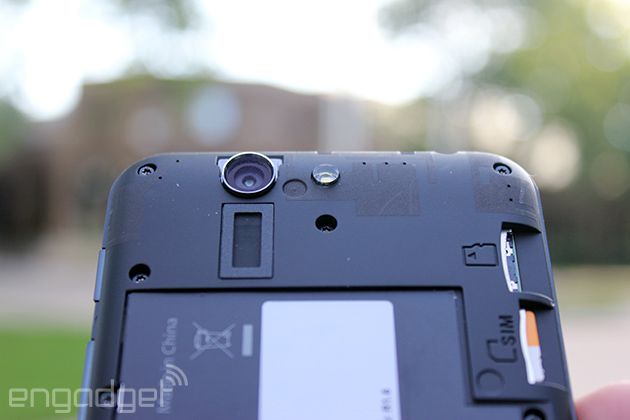
We've already established that the Padfone X doesn't stand out much -- did you really think the camera would help matters? Surprise: It's much better than you'd think, if not quite on par with other flagships. Images captured at full resolution during the day with that 13-megapixel camera were sufficiently vivid (if a tad noisy), and were detailed enough to reassure me that I wasn't missing anything crucial.
But crafting a camera that works well in the day is a relative cakewalk. What about when the sun goes down and things really start to get interesting? As it turns out, the Padfone X is a surprisingly capable shooter in dim conditions, too. ASUS likes to talk up its PixelMaster imaging mode, which lets that rear camera capture up to 400 percent more light than a less sophisticated sensor. The results are cut-and-dry: In spite of more noise to contend with, you'll wind up with an image that's much brighter than you'd see otherwise. Are they print-worthy? Maybe not, but they'll make for some nifty Instagram shots.




PERFORMANCE AND BATTERY LIFE
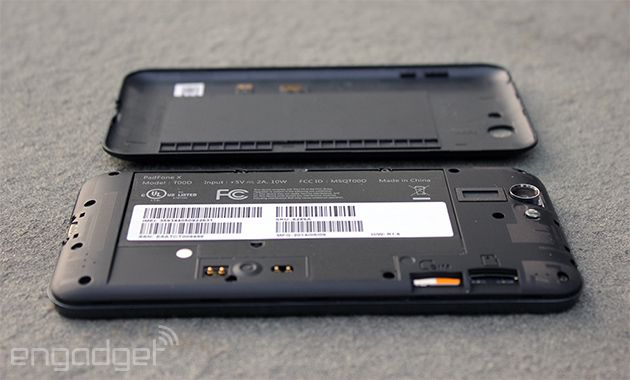
If cellphone stores were casinos, flagships like the HTC One M8 and Samsung Galaxy S5 would be those big, elaborate slot machines that lure you in with a sense of spectacle and big promises. The Padfone itself (sans tablet dock), would be that rinky-dink machine next to the cheap buffet line -- your chances of coming away satisfied might not be that different, but you'd never know it from sight alone.
Pardon the metaphor -- long story short, the X has power in spades thanks to the 2.3GHz quad-core Snapdragon 800 ticking away in that woefully unimaginative shell. It's not Qualcomm's newest bit of silicon magic, but make no mistake: The Padfone X runs like a champ. Part of that has to do with ASUS' mercifully light touch with software, letting KitKat's natural snappiness shine through as you flick past home screens and dive into menus. All that horsepower really makes itself known when you're taking corners in Need For Speed: Most Wanted -- there's nary a visual stutter or dropped frame to be seen.
The tale of the tape only confirmed what I already knew: the Padfone will easily tackle whatever you throw at it during your day-to-day grind. If only things were as peachy after you plop the phone into that tablet dock. What once was snappy and responsive becomes very slightly less so -- it's a little jarring to feel that shift when it happens, but I seriously doubt most people would pay it much mind.
Since there are two different screens and two different batteries to work with, I've had to rejigger our standard video rundown test a bit. Normally we'd fire up a 720p video file, set it to loop indefinitely at 50 percent screen brightness and let 'er rip. Under those circumstances, the Padfone hung in for eight hours and 24 minutes before finally giving up the ghost. From there, I popped the thing into the fully charged Padfone Station and cued up the video on that bigger screen, a gauntlet that lasted another six hours. Purely as a phone, the Padfone X falls short of the battery bar set by devices like HTC's One M8 and Samsung's Galaxy S5, but that's a forgivable sin. Video stress testing aside, it still consistently ran for more than 12 hours as I emailed, snapped photos and snarkily tweeted my way through the work day, and quick battery top-ups from the Padfone Station only helped stretch my productive hours even further.
THE COMPETITION
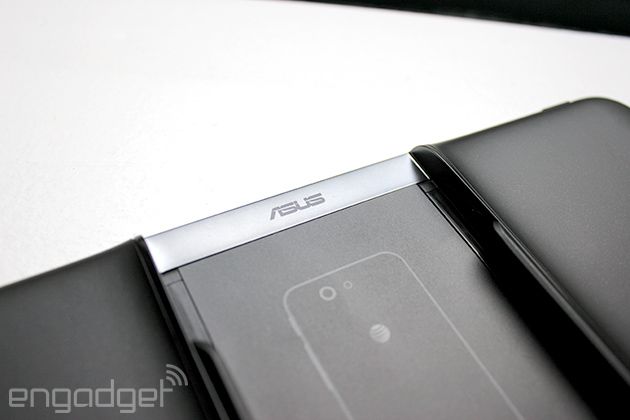
No other device tries to bridge the smartphone/tablet divide the way the Padfone does. Its closest evolutionary cousin would probably be the phablet, and there's no shortage of those taking up space on store shelves. The Samsung Galaxy Note 3 sports a 5.7-inch screen, so it doesn't always feel like a tablet, but its slew of S Pen features makes sure it feels fresh compared to less ambitious competitors. The silicon inside is awfully similar to what's ticking away in the Padfone X, too -- there's a quad-core Snapdragon 800 running the show, though it'll generally cost you about $100 more with a contract than the Padfone will.
Sony's Xperia Z Ultra might fit the bill too, since it doesn't try to hide its tablet ambitions. It's got a hefty 6.4-inch display, making it one of the biggest phablets you could try and squeeze into your skinny jeans. It too packs a Snapdragon 800, but the biggest thing to remember is that the only way you're going to get one in the States is unlocked from the Google Play Store. That means you'll be shelling out $449 since there are no contracts involved. On the off-chance that something slightly smaller might fit your bill, the HTC One M8 could work well with its top-tier spec sheet and impeccable design. At $199 with a contract though, it'll cost you just as much as a Padfone without the promise of extra flexibility. Choose wisely.
WRAP-UP
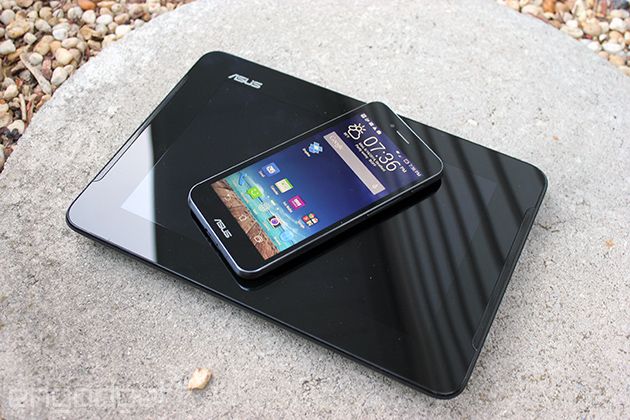
If I've seemed unduly harsh on the Padfone X, it's because I still think there's a place in the world for a hybrid like this. Sadly, despite years of tinkering with the same formula, ASUS couldn't completely stick the landing this time around. For all the gripes I've leveled at this thing, though, I've had to mentally repeat one sentence like a mantra throughout my weeks of testing: all of this is just $200 with a contract. For the same price as a single, shiny top-tier handset, you could nab yourself a very respectable smartphone and a tablet that (while flawed) still works. I'd wager there's a decent number of people out there who'd embrace that math wholeheartedly.
But are you one of them? If you've got the means, you'll almost definitely be better served by buying separate phones and tablets. The promise of seamless syncing is a tempting one, and one worth getting right. ASUS hasn't done that here. To be honest, I hope it gets another chance at cracking the brutal US market -- the right sort of design and software tweaks could turn the next-generation Padfone into a gadget worthy of our collective drool. For now, though, ponder the arithmetic and see if you can do better.
Source